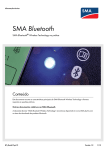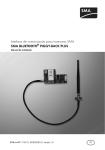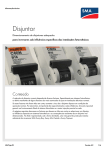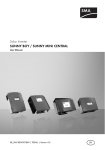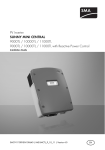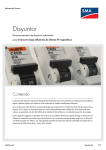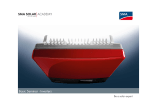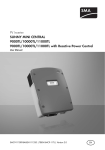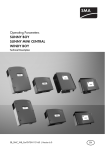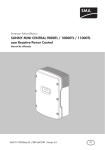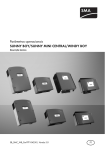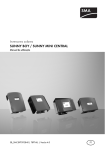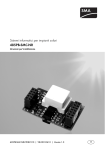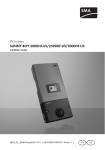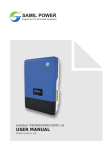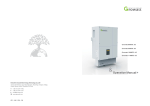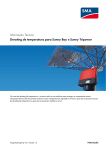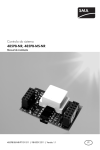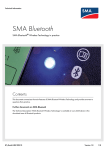Download SMA Bluetooth® Wireless Technology in practice - Gastech
Transcript
Technical Information SMA Bluetooth SMA Bluetooth® Wireless Technology in Practice Contents This document summarizes the main features of SMA Bluetooth Wireless Technology and provides answers to questions from practice. Further documents on SMA Bluetooth The technical description "SMA Bluetooth Wireless Technology" is available at www.SMA.de/en in the download area of Bluetooth products. BT_Quick-UEN110711 Version 1.1 1/16 Technical Information RS485 and Bluetooth Compared 1 RS485 and Bluetooth Compared SMA Solar Technology AG provides wired and wireless communication for PV plants. What type is suitable for your PV plant depends on your preference, the size of your PV plant and the distance between the devices. The following table provides a brief overview of the differences between wired (RS485) and wireless (Bluetooth) communication from SMA Solar Technology AG. Typical application Wired: RS485 Medium and large PV plants Advantages Number of nodes (PV plant monitoring and inverters) High speed and reliability Up to 50 per RS485 bus Number of data retrieval devices 1 device per RS485 bus (for example, Sunny Beam, Sunny WebBox) Range 1 200 m per RS485-Bus Possibility for feeding-in and grid management Power Reducer Box from SMA Solar Technology AG Wireless: Bluetooth Especially small and medium PV plants Reduced costs and effort Up to 50 per Bluetooth network (inverter and SMA Bluetooth Repeater) Up to four devices per Bluetooth network (depending on the number of nodes) Up to 100 m in the open air between individual devices None* *see section 3 "Feed-in and Grid Management" (page 14) SMA Solar Technology AG 2/16 Technical Information SMA Bluetooth 2 SMA Bluetooth 2.1 Range SMA Bluetooth has a range of up to 100 m in the open air with direct visual contact. The SMA Bluetooth PiggyBack used for retrofitting SMA inverters with Bluetooth achieves a radio range of up to 50 m outdoors with direct visual contact because of the inverter enclosure. The range depends on various influencing factors, which are partly manipulable. The following factors can influence the range: • Damping obstacles Since the devices do not often stand in direct visual range of each other, the radio signals must penetrate ceilings, walls and doors, for example. As a result of these obstacles the radio signals are weakened to various extents (damped). To what extent an obstacle damps the radio signals depends on the thickness and material of the obstacle. • Changing conditions Changing conditions are changes that can occur during operation of the Bluetooth network, such as occasionally parked vehicles or temporarily closed gates. • Reflections Radio waves that hit obstacles and are deflected from there in a different direction are called reflections. They cause radio signals to take multiple paths to reach the receiver or not to reach it at all. Depending on the local conditions, reflections can lead to the receiving conditions appearing to be better or worse than assumed when purely considering the damping effects. • Transmitting power The transmitting power of the Bluetooth node with the lower transmission power limits the possible distance between two Bluetooth nodes. If, for example, a node has a radio range of 100 m and the other nodes a radio range of 10 m, the nodes may not be more than 10 m apart. • Receiver sensitivity The receiver sensitivity is a measure of the minimum strength the radio signals must have in order that they can be received without errors. The more sensitive the device is set, the weaker the radio signals can be which the device still can perfectly receive. The receiver sensitivity depends on the hardware and software of a device. SMA Solar Technology AG 3/16 Technical Information SMA Bluetooth The following table shows the transmitting power of SMA devices with Bluetooth in free-field conditions in case of direct visual contact. The illustrated power applies to both transmitting and receiving of Bluetooth radio signals. The table is to serve as a reference when designing your PV plant. SMA Solar Technology AG has tested the transmitting power of all the devices listed in the table. The transmitting power of devices not listed in the table has not been tested. You can assume a comparable transmitting power for devices that have not been tested but are equipped with an enclosure corresponding to one of those shown in the table. For devices that have not been tested with SMA Bluetooth Piggy-Back Plus, you can assume a similar or better transmitting power than the transmitting power of the SMC 6000TL with SMA Bluetooth Piggy-Back Plus. When designing your plant, take the following factors into account: • The range depends on various influencing factors (see p. 3). • In order to determine the maximum distance between two Bluetooth nodes, the transmitting power of both of them must be taken into account. The transmitting power of the Bluetooth node with the lower transmitting power is decisive. • Depending on the enclosure side, the transmitting power of the Bluetooth node may vary. It is therefore important to consider the orientation of a Bluetooth node towards others. SMA Solar Technology AG 4/16 Technical Information SMA Bluetooth Legend: = optimum transmitting power = good transmitting power = moderate transmitting power = low transmitting power Devices with "moderate" and "low" transmitting power SMA Solar Technology AG recommends equipping devices with mainly "moderate" or "low" transmitting power with an SMA Bluetooth Repeater, an SMA Bluetooth Repeater Outdoor or an SMA Bluetooth Piggy-Back Plus. Inverters with integrated Bluetooth Tested devices (SB = Sunny Boy, SMC = Sunny Mini Central) • SB 5000TL‑20 Transmitting power, depending on the enclosure side Untested devices with comparable transmitting power (SB = Sunny Boy, SMC = Sunny Mini Central, WB = Windy Boy) Photovoltaic inverters: ‒ SB 3000TL‑20, SB 4000TL‑20 Wind power inverters: ‒ WB 3600TL‑20, WB 5000TL‑20 SMA Solar Technology AG 5/16 Technical Information Tested devices (SB = Sunny Boy, SMC = Sunny Mini Central) • SB 3000HF‑30 SMA Bluetooth Transmitting power, depending on the enclosure side Untested devices with comparable transmitting power (SB = Sunny Boy, SMC = Sunny Mini Central, WB = Windy Boy) Photovoltaic inverters: ‒ SB 2000HF‑30, SB 2500HF‑30 Wind power inverters: ‒ WB 2000 HF, WB 2500 HF, WB 3000 HF SMA Solar Technology AG 6/16 Technical Information SMA Bluetooth Inverters with SMA Bluetooth Piggy-Back Tested devices (SB = Sunny Boy, SMC = Sunny Mini Central) • SB 1700 with SMA Bluetooth Piggy‑Back Transmitting power, depending on the enclosure side Untested devices with comparable transmitting power (SB = Sunny Boy, SMC = Sunny Mini Central, WB = Windy Boy) Photovoltaic inverters: • with SMA Bluetooth Piggy‑Back: ‒ SB 1100, SB 1100E, SB 1100LV, SB 1100‑IT, SB 1200, SB 1200-IT, SB 1600TL‑10, SB 1700, SB 1700E, SB 1700‑IT, SB 2100TL, SB 2500, SB 2500‑IT, SB 2500‑KR, SB 2800i, SB 3000, SB 3000‑IT, SB 3000‑KR Wind power inverters: • with SMA Bluetooth Piggy‑Back: • SB 3800 with SMA Bluetooth Piggy‑Back ‒ WB 1100, WB 1100‑IT, WB 1100E, WB 1100LV, WB 1100LV‑IT, WB 1200, WB 1200‑IT, WB 1700, WB 1700E, WB 1700‑IT, WB 2500, WB 2500‑IT, WB 2800i, WB 3000, WB 3000‑IT Photovoltaic inverters: • with SMA Bluetooth Piggy‑Back: ‒ SB 3300, SB 3300‑IT, SB 3800, SB 3800‑IT Wind power inverters: • with SMA Bluetooth Piggy‑Back: ‒ WB 3300, WB 3300‑IT, WB 3800, WB 3800‑IT SMA Solar Technology AG 7/16 Technical Information Tested devices (SB = Sunny Boy, SMC = Sunny Mini Central) • SMC 5000 with SMA Bluetooth Piggy‑Back SMA Bluetooth Transmitting power, depending on the enclosure side Untested devices with comparable transmitting power (SB = Sunny Boy, SMC = Sunny Mini Central, WB = Windy Boy) Photovoltaic inverters: • with SMA Bluetooth Piggy‑Back: ‒ SB 4200TL HC, SB 4200TL HC‑IT, SB 5000TL HC, SB 5000TL HC‑IT SMA Solar Technology AG 8/16 Technical Information Tested devices (SB = Sunny Boy, SMC = Sunny Mini Central) SMA Bluetooth Transmitting power, depending on the enclosure side Untested devices with comparable transmitting power (SB = Sunny Boy, SMC = Sunny Mini Central, WB = Windy Boy) Photovoltaic inverters: • SMC 11000TL with SMA Bluetooth Piggy‑Back • with SMA Bluetooth Piggy‑Back: SUNNY string L CENTRA in Germany MINI* Made inverter Photovoltaic SMC 11000TL-10 97 20001549 I AC nom cos ϕ *XXX* ‒ SMC 4600A, SMC 5000, SMC 5000A, SMC 5000A‑IT, SMC 6000, SMC 6000A, SMC 6000A‑IT, SMC 6000A‑KR, SMC 7000HV, SMC 7000HV‑IT, SMC 7000HV‑11, SMC 7000HV‑11/IT, SMC 6000TL, SMC 6000TL‑IT, SMC 7000TL, SMC 7000TL‑IT, SMC 8000TL, SMC 8000TL‑IT, SMC 8000TL‑KR, SMC 9000TL‑10, SMC 9000TL‑10/IT, SMC 10000TL‑10, SMC 10000TL‑10/IT, SMC 11000TL‑10, SMC 11000TL‑10/IT, SMC 9000TLRP‑10, SMC 10000TLRP‑10, SMC 11000TLRP‑10 Wind power inverters: • with SMA Bluetooth Piggy‑Back: ‒ WB 5000A, WB 5000A‑IT, WB 6000A, WB 6000A‑IT SMA Solar Technology AG 9/16 Technical Information SMA Bluetooth Inverters with SMA Bluetooth Piggy-Back Plus Tested devices (SB = Sunny Boy, SMC = Sunny Mini Central) • SMC 6000TL with SMA Bluetooth Piggy‑Back Plus Transmitting power, depending on the enclosure side Untested devices with comparable transmitting power (SB = Sunny Boy, SMC = Sunny Mini Central, WB = Windy Boy) Photovoltaic inverters: • with SMA Bluetooth Piggy‑Back Plus: ‒ SMC 4600A, SMC 5000, SMC 5000A, SMC 5000A‑IT, SMC 6000, SMC 6000A, SMC 6000A‑IT, SMC 6000A‑KR, SMC 7000HV, SMC 7000HV‑IT, SMC 7000HV‑11, SMC 7000HV‑11/IT, SMC 6000TL, SMC 6000TL‑IT, SMC 7000TL, SMC 7000TL‑IT, SMC 8000TL, SMC 8000TL‑IT, SMC 8000TL‑KR, SMC 9000TL‑10, SMC 9000TL‑10/IT, SMC 10000TL‑10, SMC 10000TL‑10/IT, SMC 11000TL‑10, SMC 11000TL‑10/IT, SMC 9000TLRP‑10, SMC 10000TLRP‑10, SMC 11000TLRP‑10 Wind power inverters: • with SMA Bluetooth Piggy‑Back Plus: ‒ WB 5000A, WB 5000A‑IT, WB 6000A, WB 6000A‑IT SMA Solar Technology AG 10/16 Technical Information SMA Bluetooth Communication devices Tested device • Sunny WebBox with Bluetooth Transmitting power, depending on the enclosure side • Sunny Beam with Bluetooth • SMA Bluetooth Repeater SMA Solar Technology AG 11/16 Technical Information SMA Bluetooth 2.2 Number of Nodes Up to 50 devices with the same NetID can participate in an SMA Bluetooth network* . These devices include inverters and SMA Bluetooth Repeaters. In case you want to link more than 50 devices, you have to divide your PV plant into several Bluetooth networks by assigning them different NetIDs. If your Bluetooth PV plant consists of 90 devices, for example, you can assign the NetID 3 for 45 devices and the NetID 4 for the remaining 45 devices. In this case, divide the PV plant into Bluetooth networks with an approximately equal number of devices (example: PV plant with 90 devices should not be divided into 60 and 30 devices, but into 45 and 45 devices). The fewer devices there are within a NetID, the faster the network structure and the data transmission are. *When the Sunny Explorer is used, the number of nodes depends on the number of masters; see section "Sunny Explorer and number of slaves" (page 13). 2.3 Masters and Slaves Masters and slaves are terms used in network technology. In a network, a master is a device that, for example, requests other devices (slaves) to receive or send data. In a Bluetooth network from SMA Solar Technology AG, the following products are masters and slaves: Role Master Products • Communication products, e.g.: ‒ Sunny WebBox with Bluetooth ‒ Sunny Beam with Bluetooth Slave ‒ Sunny Explorer (software for computer) • Inverter • SMA Bluetooth Repeater SMA Solar Technology AG Characteristics • Initiates the setup of the Bluetooth network. • Requests data • Sends data to slaves • Implements the requests and inputs of the master 12/16 Technical Information SMA Bluetooth 2.4 Number of Masters in the Bluetooth Network A maximum of 4 masters can participate in a Bluetooth network at the same time. However, the number of masters depends on the number of slaves. The root node (A) is the slave which the master directly connects to the Bluetooth network and initiates the setup of the complete Bluetooth network. Two masters can connect with this slave. Every other inverter can only accept the connection of one master. In order to participate simultaneously with the maximum number of 4 masters in a Bluetooth network, at least 3 slaves are required. Number of slaves Possible number of masters (Inverter or SMA Bluetooth Repeater) 1 2 3 >3 (e.g. Sunny Beam with Bluetooth, Sunny Explorer) 2 3 4 4* *For PV plants with Sunny Explorer, note the following section. Sunny Explorer and number of slaves With Sunny Explorer you can manage up to 50 devices (slaves). If you want to use other communication products besides Sunny Explorer, your PV plant should comprise fewer slaves. The following table lists the number of possible slaves: Number of masters 1 Sunny Explorer 1 Sunny Explorer and 1 other communication product 1 Sunny Explorer and 2 other communication products 1 Sunny Explorer and 3 other communication products SMA Solar Technology AG Possible number of slaves up to 50 up to 25 up to 12 3 to 6 13/16 Technical Information Feed-in and Grid Management 3 Feed-in and Grid Management Feeding-in and grid management means that in the event of a grid overload, the distribution grid operator can remotely limit the feed-in power of the PV plant. The PV plant must be equipped with a system that allows the distribution grid operator to limit the power for the sake of safety. Information on regulations for feeding-in and grid management in your country can be obtained from your distribution grid operator. For PV plants with planned grid management, SMA Solar Technology AG recommends wired communication. Using wired communication ensures that the distribution grid operator has access to the PV plant at all times. The following figure shows the solution from SMA Solar Technology AG for PV plants that must contribute to feed-in management. The Power Reducer Box allows the distribution grid operator to implement active power limitation or reactive power specification. The Power Reducer Box can be used only with wired PV plants. SMA Solar Technology AG 14/16 Technical Information Safety of SMA Bluetooth 4 Safety of SMA Bluetooth SMA Solar Technology AG offers inverters of different power classes with SMA Bluetooth. Measurement, event, and counter information can be retrieved and parameters changed wirelessly via SMA communication products. SMA Solar Technology AG provides a comprehensive security concept that protects the Bluetooth devices of your PV plant from unauthorized access. • Plant password: securing all Bluetooth devices of your PV plant via a system password, transmitted encrypted, for each user group (user/installer) • SMA Grid Guard: controlled access to safety-relevant parameters via SMA Grid Guard Plant password The inverters with integrated Bluetooth or an SMA Bluetooth Piggy-Back are delivered ex works with preset plant passwords. These are the same for all SMA Bluetooth Piggy-Backs and all inverters with Bluetooth. To protect the PV plant from unauthorized access, you should change the default plant passwords for the user groups "Installer" and "User" or set the NetID of all inverters to 0 (Bluetooth switched off) when no wireless plant communication is to be used. However, SMA Solar Technology AG recommends changing the plant passwords since the preset NetID 1 and higher facilitates access for a service technician. You can change the plant passwords by using a computer with Bluetooth and the Sunny Explorer software or by means of a Sunny WebBox with Bluetooth. How to change the plant passwords is described in the user manual of the Sunny Explorer and/or the user manual of the Sunny WebBox with Bluetooth. You can obtain the Sunny Explorer for free in the download section of www.SMA.de/en. Inform the user of the changed user password. SMA Grid Guard SMA Grid Guard is a security concept for country-specific settings in the inverter, determining the network behavior within a power distribution grid. These settings (SMA Grid Guard parameters) are pre-installed in the devices and can only be configured with the SMA Grid Guard password. In order to change SMA Grid Guard parameters, you must be logged in as an installer and you will also need your personal SMA Grid Guard password, which you can obtain from SMA Solar Technology AG. Contact the SMA Serviceline. SMA Solar Technology AG 15/16 Technical Information Storage Capacity of the Inverters 5 Storage Capacity of the Inverters Inverters with integrated SMA Bluetooth Inverters with integrated SMA Bluetooth have the following storage capacity: • Total yield "E-total" in 5-minute averages for 63 days • Daily yield "E-day" as end-of-day values for 30 years • 250 "Events" for the user group "User" • 250 "Events" for the user group "Installer" Inverters with retrofitted SMA Bluetooth (SMA Bluetooth Piggy-Back and SMA Bluetooth Piggy-Back Plus) The value "E-day" can be saved by inverters with retrofitted SMA Bluetooth as of the SMA Bluetooth PiggyBack firmware version 2.00.01.R or as of the SMA Bluetooth Piggy-Back Plus firmware version 2.00.03.R. Otherwise, these inverters have the same storage capacity as inverters with an integrated SMA Bluetooth. However, the SMA Bluetooth Piggy-Back and the SMA Bluetooth Piggy-Back Plus can save the data only if a master is connected to the PV plant at least once a day thus transmitting the time. The reason is that otherwise the SMA Bluetooth Piggy-Back and the SMA Bluetooth Piggy-Back Plus cannot assign the data any time and date and therefore cannot save it. Note that the master can connect to the inverter and an SMA Bluetooth Piggy-Back or an SMA Bluetooth Piggy-Back Plus only when the inverter is in feed-in operation. SMA Solar Technology AG 16/16

















